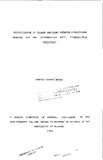| dc.description.abstract | schistosomiasis is a major health problem especially in
the developing countries within the tropics. The search
for an effective vaccine has however been frustrated by
two main contraints namely, the antigenic complexity of
the parasite and the difficulty of producing adequate
research material from the tiny parasite stages. These
two problem would be overcome if an alternative source
of immunising antigens could be found. The present work
involved a search for such antigens from the snail
vector of Schistosoma mansoni, Biomphalaria pfeifferi.
Antigen fractions from various parts of the vector snail
were isolated using conventional immunochemical
techniques. Similarly antigens were obtained from
different stages of S- mansoni using homogenisation and
centrifugation techinques. A battery of antisera of all
the antigenic preparations were raised in the rabbits
and antigenic cross-reactivity was investigated using
gel diffusion technique. The potency of each antisera
was ascertained by reacting it with its homologous
antigen. The results obtained clearly indicate that
both the digestive gland and the alimentary canal of the
snail vector, possess antigens which cross-react with S-
mansoni egg antigens. No such cross-reactivity was
detected between the foot of ofeifferi and any of the
stages of S- mansoni. Similarly, no shared antigens were detected between the digestive gland of
the non-vector snail Bulinus africunus and S- mansoni.
In order to establish their immunising potential and the
degree of protection, the snail antigens were used to
immunise groups of hamsters and the numbers of adults
worms recovered from the immunised groups were compared
with those from control groups. The results were
statistically significant and indicated that the best
protection was achieved using antigenic preparations
from either digestive gland or the alimentary canal of
the snail. The percentage worm reduction for the
digestive gland and its two antigenic fractions were
28.5%, 65.0% and 52.4% respectively, while that of the
alimentary canal and its two antigenic fractions were
45.6%, 52.6% and 56.6% respectively. The least worm
reduction was obtained from the foot and its two
antigenic fractions. These were 12.3%, 26.2% and 24.6%
respectively.
The results therefore, of both antigenic crossreactivity
and immunisation experiments strongly suggest
the presence of shared antigens between Schistosoma
mansoni eggs and the intermediate host, Biomphalaria
pfeifferi.
These results agree with those obtained by other workers.
Lehman and Ruahini (1982) obtained 63.9% protection against ~ mansoni when they immunised mice using crude
extracts of the whole snail, pfeifferi. Similarly
Carlos et ale (1985) found out that the digestive gland
of S- mansoni's Puerto Rican vector, Biomphalaria
grabrata shared 2.8% of its antigens with S-mansoni.
suggestion are made for further research work in trying
to develop a vaccine against schistosomiasis | en |

